Plot Wizards #2: "Six of a Chain"
Posted by August Lenninger on Oct 16th 2019
An editorial analysis of Dime Western, Star Western, Dime Mystery, Terror Tales, The Spider, and Operator No. 5.
by August Lenninger
This article originally appeared in Writer's Digest, January 1935.
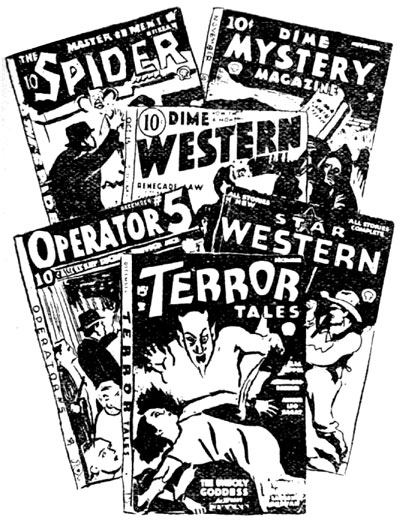 THE American West was one
of the most glamorous frontiers the world ever knew. In building that frontier
into the West of today, in conquering its privations and dangers, friend and
bitter foe often fought shoulder to shoulder. Many of the most respected, heroic
figures of those days were blackguards at heart; many of the most notorious
outlaws and badmen performed noble acts of mercy, loyalty and self-sacrifice.
The politician, the soldier, the gambler, the railroad-builder, the women of
the honkytonks played as great a part in the inexorable advance of that
frontier as the traditionally honest cowboy, sheepman or sheriff and the
virtuous women they sometimes married.
THE American West was one
of the most glamorous frontiers the world ever knew. In building that frontier
into the West of today, in conquering its privations and dangers, friend and
bitter foe often fought shoulder to shoulder. Many of the most respected, heroic
figures of those days were blackguards at heart; many of the most notorious
outlaws and badmen performed noble acts of mercy, loyalty and self-sacrifice.
The politician, the soldier, the gambler, the railroad-builder, the women of
the honkytonks played as great a part in the inexorable advance of that
frontier as the traditionally honest cowboy, sheepman or sheriff and the
virtuous women they sometimes married.
It is the spirit of that glamorous, realistic West which existed from the buckskin days until the beginning of our twentieth century that Rogers Terrill, the editor of Dime Western and Star Western wishes to reflect in his magazines. He wants western stories peopled by real men and women; stories where the heroes aren't two-gun idols of integrity, where the heroines aren't necessarily placed upon a pedestal of modesty and virtue, where even the villains may make a noble gesture or die in a blaze of glory. The mature western, in other words, that adults as well as youthful readers can enjoy.
"We need stories with meaty plots which are the outgrowth of colorful and honest characterization," Mr. Terrill says. "Primarily there must be real emotion in our stories; in addition to the physical conflict, they should have emotional drama. A story, for example, in which conflicting forces are at work, in which the hero has strongly conflicting desires — where he must make a choice that will reflect his true character. His most vital interests and desires require one course of action, but a debt of honor demands sacrifice of his own will. And while he is sorely tempted to protect his own interests, his better nature triumphs.
"The drama in our stories is not obtained by a blast of six-gun slugs in every paragraph, nor western atmosphere developed by having the characters use 'yuh' in their dialogue. The kind of drama we want is obtained by appealing to the traditional emotions — loyalty, sacrifice, courage. The western atmosphere we desire is developed naturally through characterization, colorfully descriptive action and plot situations peculiar to the West. We like stories that reflect man's conflict with nature, where that conflict is so intensely bitter that friend and foe join hands in fighting it. We especially seek stories that have an epic sweep, where the result of the action will change the history of that community and where there is something far more vital at stake than the personal problem of the hero and heroine. And we like the story of the tough bad-man who realizes he is bad but who has an opportunity to fight in self-sacrifice for the heroine.
"We don't want mock heroics. Our stories must be sincere; they should be based upon dramatic situations which are the outgrowth of the emotional forces actuating real men and women typical of those who developed the American West."
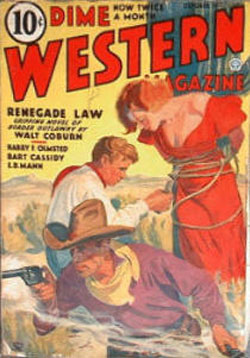 To give you concrete
examples of what he wants for his western books Mr. Terrill selected a
novelette each from Dime Western and Star
Western to illustrate his policy. Here they are: "Renegade
Law by Walt Coburn in the October 15th issue of Dime
Western is set against a colorful border-country background.
Bill Poe and Laredo Jamison both ride for the crooked gambler, Fox. Laredo gets
old Doc Pattison drunk and buys a horse belonging to his daughter Pat. Pat is
furious; tries to buy it back, but Laredo refuses. Poe fights Laredo and
forces him to return the horse. Poe vows he's through with Fox and his crooked
henchmen, strikes out on his own. He defeats Laredo in the rodeo despite Fox's
"fixing" and causes the gambler to lose thousands. Then Laredo has a
pal get old Doc Pattison into a crooked poker game, dope his drink and
"win" his ranch and stock. Laredo attempts to sell the papers to Fox
for a fancy price. Fox, in turn, double-crosses Laredo and has them stolen. The
gambler realizes Poe is more valuable to him than Laredo and through Pat can
now bring him to terms. Yes, Bill Poe sells his soul to Fox in order to turn
that ranch back to Pat. He tells her that his sidekick, Nigger Ben, won it back
gambling. And Pat is disgusted with Bill when he tells her he is again riding
for the crooked gambler.
To give you concrete
examples of what he wants for his western books Mr. Terrill selected a
novelette each from Dime Western and Star
Western to illustrate his policy. Here they are: "Renegade
Law by Walt Coburn in the October 15th issue of Dime
Western is set against a colorful border-country background.
Bill Poe and Laredo Jamison both ride for the crooked gambler, Fox. Laredo gets
old Doc Pattison drunk and buys a horse belonging to his daughter Pat. Pat is
furious; tries to buy it back, but Laredo refuses. Poe fights Laredo and
forces him to return the horse. Poe vows he's through with Fox and his crooked
henchmen, strikes out on his own. He defeats Laredo in the rodeo despite Fox's
"fixing" and causes the gambler to lose thousands. Then Laredo has a
pal get old Doc Pattison into a crooked poker game, dope his drink and
"win" his ranch and stock. Laredo attempts to sell the papers to Fox
for a fancy price. Fox, in turn, double-crosses Laredo and has them stolen. The
gambler realizes Poe is more valuable to him than Laredo and through Pat can
now bring him to terms. Yes, Bill Poe sells his soul to Fox in order to turn
that ranch back to Pat. He tells her that his sidekick, Nigger Ben, won it back
gambling. And Pat is disgusted with Bill when he tells her he is again riding
for the crooked gambler.
Laredo attempts to have Fox murdered at a banquet and Poe saves the life of the man he hates. Fox is not ungrateful. He puts Poe in charge of a ranch south of the Rio which had been a blind for rustling, and gives Poe a free hand to run it honestly. Laredo takes the outlaw trail and harasses the Fox ranch mercilessly with the aid of crooked Mexican and American border officials. Laredo becomes a Robin Hood to the border ranchers who hate Fox, and through Doc Pattison he insidiously slanders Poe; finally almost win's Pat's confidence.
The showdown comes when Pat rides into Mexico to warn Poe of a death-trap Laredo has set for hi,m. She meets Fox when she arrives too late to warn Poe. The gambler reveals a redeeming trait of chivalry by telling her the truth of his bargain with Bill. Together they ride to Laredo's outlaw stronghold; bitter enemies, but united in a mutual desire to save Poe's life. Laredo and the Mexican girl who ostensibly had been Pat's rival, are killed; Fox mortally wounded, but before he cashes in the gambler makes the noble gesture of leaving his fortune to Bill and Pat.
The human-interest touches that make this story different from the usual western are primarily the characterizations. Pat's father loves his "likker" and his horse-trading, but he's a lovable old man. Fox, although unscrupulous, is enough of a man to appreciate a good turn. And he's a keen judge of character—he knows Bill Poe won't go back on his bargain. There are also Nigger Ben, satellite and foil for the hero, a colorful comedy-relief character; the Mexican dancer who lives without benefit of clergy with Laredo, and with whom Poe has to associate in following Fox's orders— and there's the hero himself, who although honest in his actions and intentions, has had a somewhat shady past which he is living down. Honestly characterized story people, all of them — human beings. The villains aren't without virtues, nor the hero without blame. Renegade Law is a story of intrigue, conflicting character and emotion with its suspense and drama the outgrowth of these elements — gun-play takes part in only the final scene.
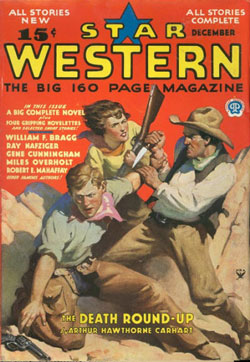
• In "Two Trails To Death," Ray Nafziger employs a youthful hero, Vic Gregg. Vic's brother and best friend have been mortally wounded by the gunmen in Redwood Gallatin's gambling palace after accusing a dealer of cheating. The notorious outlaw Brill has taken a hand, covering Vic's retreat. First the friend, then Vic's brother, drop from their horses, dead. Brill comes up to Vic who is swearing vengeance against Gallatin. Here's a bit of that scene, which will show you the kind of realistic treatment and characterization Mr. Terrill likes:
His hand fell on Vic's shoulder. "I wish I could say something, boy. Sometime maybe you'll see the end of men like Redwood Gallatin and Buck Doak, and the rest—and the end of their deadfall places. I know what you're thinkin'. Take my advice and forget it. The world is full o' Gallatins, and in the end the world sees that they get what's coming to them. I got to be leaving you now, youngster. Got a date up at Wells, north o' here. You've got a lonely trip with these two, and you'll have a lonely time for a while without your brother. But time helps—it may even help you to forget yore ideas of revenge."
But Vic later learns that Tovrey, the rancher for whom he is riding, is in league with Brill, and that they plan a raid on Gallatin's place. Vic begs a chance to avenge his brother; Brill reluctantly agrees, forcing Vic's promise it will be his only outlaw trick. Vic is wounded in saving one of the outlaws during the raid; Brill ingeniously gets Vic to safety with the Barstows, an old couple who treat him as their own son and nurse him back to health. That raid was only partly successful; another is planned, and once more Vic persuades Brill to let him take part. While waiting in a nearby town to meet the others at an appointed time, Vic learns that a dam built by Gallatin with faulty materials is about to break and wipe out the town and the valley of honest ranchers below it. The town where Vic had found sanctuary with that kind old couple. Suddenly, Tovrey, twisted with rheumatism, drops from a lathered horse, tells Vic he has learned Brill is going into a death-trap, that it's up to Vic to stop that raid. But at that moment the news comes that the dam is cracking, that it will let go in a matter of minutes. There is nobody but Vic to warn the people in the path of the flood.
Here's a dramatic crisis, and this is how Ray Nafziger handles it:
And yet there was one thing in Vic Gregg's code that was the unforgivable thing; treachery to a friend. To throw down Brill—it was unthinkable. The man had been closer to him than a brother.
The old man was still shouting and the bell was ringing furiously in the house as Vic spurred away For a moment he could not tell in which direction he was racing: whether across the ridge toward Elto to warn Brill, or along the mesa to dip into Left Hand Canyon to warn the town.
It was only after a hundred yards that he saw he had taken the trail to Bristow, to save the people of that peaceful little town. Answering a law higher than friendship, drawn by a force stronger than that which drew him to Brill.
The drumming of the hoofs of his horse sounded to him like the guns that would be crashing in Elto, riddling Jim Brill and the men with him, leaving their bodies strewn over the floor of Redwood Gallatin's place . . .
Vic succeeds in saving the inhabitants of the valley, personally rescues the Bristows —then guiltily rides to Elto. He is only in time to find Gallatin's place in flames, and Brill, the sole survivor of the attackers, holed up on the mountainside, mortally wounded. Vic brings Brill to safety, but Brill is dying. Then Vic miserably confesses his "treachery"—and Brill tells him he's proud of the decision Vic made. The Bristows were Brill's parents. And with his last breath Brill makes Vic promise to desert the longrider trails.
Here we have a situation that has tremendous emotional power—a boy anxious to save his best friend, to lay down his life for him if necessary, denied that privilege by a higher call of duty. The story has a semi-tragic ending, for the reader is as heartbroken as Vic at Brill's death, yet knows it was inevitable. Mr. Terrill will also use short stories that have a definitely tragic ending. He feels that it is good to put in one like that occasionally for variety, and also so that the reader won't take it for granted that the sympathetic characters are inevitably going to win out. It creates greater suspense in all of his stories
***
THE policy of Dime Western and Star Western is decidedly elastic. Mr. Terrill prefers girl interest, but an outstanding yarn with real emotional power but minus the ladies, has just as good a chance. He will use after-marriage romance situations, even risqué situations if tactfully handled and essential to the story — if they work it naturally with the action problem. While he wants emotion in all of his stories, he doesn't want sentimentality; in the romance scenes, for example, he prefers you to emphasize the repressed emotions of strong men and women under dramatic circumstances, such as when both of them realize they are about to be parted by death. And if you put a gun-duel into your story, give the real emotions of your sympathetic character as he faces his antagonist, expecting to die.
Don't send Mr. Terrill the conventional blood-and-thunder western action story. "The majority of the manuscripts we have to send back are rejected because they are the old, artificial bang-bang stuff utterly lacking in real characterization and dramatic punch," he says. And don't show him stories of the modern west featuring automobiles or airplanes. He wants his fiction to portray the frontier days.
Dime Western is issued twice a month; Star Western is a monthly. They are identical in policy and are wide open for short stories up to 6000, novelettes of 10,000 and short novels of 20,000 words. You'll have to read the magazines to get their exact slant before you can expect to hit them.
***
IN contrast to the policy of faithfully portraying the glamorous adventure of the frontier West, Mr. Terrill goes in for the grotesque and weird in Terror Tales and Dime Mystery. In these magazines he demands what might be termed "synthetic realism," for lack of a better expression. He wants you to send hot and cold chills creeping up the reader's spine by creating a convincing illusion that will inspire stark emotional terror.
"To describe accurately the emotional effect we seek in Terror Tales and Dime Mystery, it is first necessary to make clear the difference between horror and terror," Mr. Terrill explained. "Horror is the emotion we feel when we see something hideous, gruesome, sordid; something that we find extremely disgusting or revolting. Terror is the emotional effect produced by extreme fear; it is horror brought home to us personally, the knowledge of something horrible about to happen to us or to someone dear to us, and which menace we are almost powerless to combat.
"Our stories usually concern a young man and a young woman in love, either married or sweethearts, and terror menaces both of them. The emotional effect of terror felt for someone else is far stronger than fear for oneself. Where a terrible menace threatens a man and woman in love, they will fight like hell for each other. There's usually a good opportunity to play up self-sacrifice in such a situation, too. Our stories may be either from the girl's or the man's viewpoint. They may be either in third person or in first person, but in the definitely supernatural yarns we believe the first-person presentation lends veracity. Quite a few of our supernatural stories end somewhat up in the air: they leave a note of doubt with the reader. 'The newspapers claimed this was the explanation of the affair,' the narrator states, 'but man, I lived through it!'
"We want an eerie, uncanny type of menace, which may seem supernatural as the story progresses, but which can be logically explained at the end—or it may be definitely supernatural. The villain should preferably be hidden from the reader, although he should be present through the story, unsuspected. For example, the villain might make a friend of the hero who thinks he is the one man who can be trusted; or the girl, alone with a group of suspects, may pick out the one who seems least likely to be the fiend, appeals to him for protection—and then finds herself completely in his power.
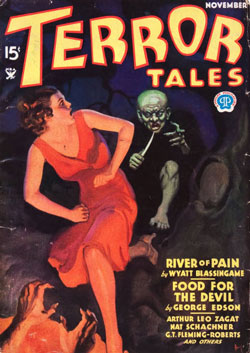
"We will permit a fairly heavy sex angle; in fact our villains are often sadistic. Risqué situations are permissible provided they are handled tactfully and are a logical, necessary part of the horror-menace situation.
"But we decidedly do not want a detective story, nor a detective hero. The hero should be a layman trying to escape from overwhelming menace, trying to protect his sweetheart, wife, or other loved one. He should not only escape the menace, but should eradicate it by his own efforts."
An example of what Mr. Terrill uses in Terror Tales can be gathered from the following brief outline of "Monsters of the Pit" by Nat Schachner in the November issue. In this novelette Phillip Rollins and his young bride, honeymooning in the wastes of the Northland, stumble into an old volcano inhabited by the tribe of Primitive men. The hero, bound to a pillar of rock, sees his wife cut up and tortured in a horrible sacrificial orgy to their Pain God. A renegade white man, previously captured by the beastmen, pretends to help Philip rescue his wife, but really tries to kill him so as to take the girl for himself. A timely eruption permits Philip to escape and rescue his wife in the chaos, and to overcome the white villain. The story ends on a note of disbelief when Philip and his bride stumble into civilization and tell their story—but the reader is left with the illusion that it really did happen.
***
“IN Dime Mystery Magazine we want the same strong emotional terror, but are more apt to demand a definite mystery angle," Mr. Terrill explained. "Here we also prefer lay characters who by force of circumstances are thrown into a terrific plight, where there is a sinister menace against the hero and heroine. We do our best to keep away from detective characters of any kind; the newspaper reporter is also overdone. Doctors, lawyers, clerks, lay figures in ordinary walks of life are the best material. And in Dime Mystery we demand a convincing motivation for the villain's actions. He may be mentally unbalanced, may be suffering from a complex, but he should be fiendishly clever, should have a sound reason for his villainy. We will permit a strong scientific angle if within the realm of the possible, but we prefer to avoid the pseudo-scientific. And in all cases the villain should be brought to heel by the direct efforts of the hero."
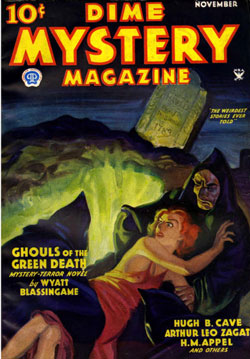
• "The Doom Dust" by Arthur Leo Zagat in the November Dime Mystery is typical of what Mr. Terrill uses. Stella Warren receives a phone call late at night from her absent husband. John tells her she will receive a letter in the morning explaining his locked laboratory which she has never entered. She is to save a black notebook at all costs, and she should watch Lois. Stella hears a scuffle over the wire; the connection is broken. She doesn't know what has happened to John or where he is.
Lois is a college-mate of Stella, visiting the Warrens. Stella distrusts her for she has been trying to "make" John. Stella also distrusts Wan, their Chinese servant. She sleeps before the laboratory door; during the night there are prowlers about the house, but Wan, upon investigating the grounds, tells her there was no one about. In the morning when the mail buggy arrives, Stella is horrified. The mailman is dead; a terrible fungus grows before her eyes on his face and hands. The letter has been stolen. Stella suspects Wan of the outrage. Then Lois comes screaming about dog-men who had attempted to kill her in back of the house.
Stella rushes to the laboratory; finds the door slightly ajar, enters intense blackness. She eludes the clutches of the prowler, drops off her clothes so her movements will be silent, gets the book. In desperate hand conflict with the dog-man, Stella smashes a bottle of nitric acid over his head: kills him. A fire results from spilled chemicals; the door has been locked — Stella is trapped in the blaze. Someone pounds on the door: a shot follows. Stella faints.
Stella regains consciousness in the foyer. The dead body of Lois is beside her. She hides the book under the body; picks up the revolver Lois had dropped. Wan comes in with a bloody knife in his hand. Stella knows he killed Lois. Why doesn't he finish her off, too? Instead he offers to get her some clothes. Stella plans to shoot him. But then Wan joyously cries that Mister John is returning. Stella jumps to the window — sees John, and two hideous men sneaking up on him. She fires and kills them.
John had managed to overcome his captors and now explains it all. The precious book contains the formula for a new explosive gas he's just sold to the American government. The "dog-men" were Ainus, half-savage denizens of Saghalien, in the employ of a spy-master; Lois also was working for the spy. Wan, loyal servant, had saved Stella's life a dozen times; he had accounted for several Ainus prowlers, had killed Lois when she tried to shoot him as he was breaking down the door of the laboratory to save Stella from the fire. The fungus-death used by the Ainus and by Lois also has a scientific explanation.
"Writers who want to sell to Terror Tales and Dime Mystery should carefully study these books before sending in stories; fiction must be specially written to fit them," Mr. Terrill warns. "Most of the scripts we have to return on these magazines fall down because they are revolting horror stories without the emotional terror we require. Or, the writers send us detective stories — yarns which may be perfectly all right for some of the detective magazines—but which are entirely out of line with our requirements. We certainly are urgently in need of good stories written directly to fit our policy. We use shorts to 6,000, novelettes of 10,000 and novels of about 17,000 words in these two magazines."
***
MR. TERRILL also has two action-detective magazines, The Spider and Operator 5. These offer only a limited market, for the lead stories are written to order. But they buy two or three short stories of about 5,000 words for each.
"In The Spider we want the story of the crime fighter who is a sort of Robin Hood, or who engages in it for the spirit of adventure, or a combination of both," Mr. Terrill told me. "They should be essentially fast-action stories in which the villain is diabolically clever, but the hero manages to outwit him. The story where the hero is in constant physical danger and comes to grips with the villain—not the deductive detective story with fancy clues."
"In Operator 5 the short stories must feature a Secret Service operative who should be fighting a menace of national importance. The locale should be either the United States or one of its possessions."
These six magazines are brought out by Popular Publications, Inc., at 205 East 42nd St., N.Y.C.
Bulletin: Popular have another pulp to its string—"Horror Tales."
— from Writer's Digest, January 1935

